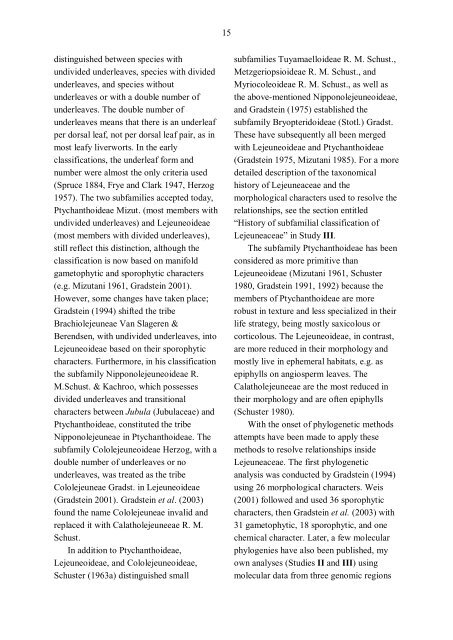Evolutionary relationships of liverworts with a special focus ... - Doria
Evolutionary relationships of liverworts with a special focus ... - Doria
Evolutionary relationships of liverworts with a special focus ... - Doria
Create successful ePaper yourself
Turn your PDF publications into a flip-book with our unique Google optimized e-Paper software.
15<br />
distinguished between species <strong>with</strong><br />
undivided underleaves, species <strong>with</strong> divided<br />
underleaves, and species <strong>with</strong>out<br />
underleaves or <strong>with</strong> a double number <strong>of</strong><br />
underleaves. The double number <strong>of</strong><br />
underleaves means that there is an underleaf<br />
per dorsal leaf, not per dorsal leaf pair, as in<br />
most leafy <strong>liverworts</strong>. In the early<br />
classifications, the underleaf form and<br />
number were almost the only criteria used<br />
(Spruce 1884, Frye and Clark 1947, Herzog<br />
1957). The two subfamilies accepted today,<br />
Ptychanthoideae Mizut. (most members <strong>with</strong><br />
undivided underleaves) and Lejeuneoideae<br />
(most members <strong>with</strong> divided underleaves),<br />
still reflect this distinction, although the<br />
classification is now based on manifold<br />
gametophytic and sporophytic characters<br />
(e.g. Mizutani 1961, Gradstein 2001).<br />
However, some changes have taken place;<br />
Gradstein (1994) shifted the tribe<br />
Brachiolejeuneae Van Slageren &<br />
Berendsen, <strong>with</strong> undivided underleaves, into<br />
Lejeuneoideae based on their sporophytic<br />
characters. Furthermore, in his classification<br />
the subfamily Nipponolejeuneoideae R.<br />
M.Schust. & Kachroo, which possesses<br />
divided underleaves and transitional<br />
characters between Jubula (Jubulaceae) and<br />
Ptychanthoideae, constituted the tribe<br />
Nipponolejeuneae in Ptychanthoideae. The<br />
subfamily Cololejeuneoideae Herzog, <strong>with</strong> a<br />
double number <strong>of</strong> underleaves or no<br />
underleaves, was treated as the tribe<br />
Cololejeuneae Gradst. in Lejeuneoideae<br />
(Gradstein 2001). Gradstein et al. (2003)<br />
found the name Cololejeuneae invalid and<br />
replaced it <strong>with</strong> Calatholejeuneeae R. M.<br />
Schust.<br />
In addition to Ptychanthoideae,<br />
Lejeuneoideae, and Cololejeuneoideae,<br />
Schuster (1963a) distinguished small<br />
subfamilies Tuyamaelloideae R. M. Schust.,<br />
Metzgeriopsioideae R. M. Schust., and<br />
Myriocoleoideae R. M. Schust., as well as<br />
the above-mentioned Nipponolejeuneoideae,<br />
and Gradstein (1975) established the<br />
subfamily Bryopteridoideae (Stotl.) Gradst.<br />
These have subsequently all been merged<br />
<strong>with</strong> Lejeuneoideae and Ptychanthoideae<br />
(Gradstein 1975, Mizutani 1985). For a more<br />
detailed description <strong>of</strong> the taxonomical<br />
history <strong>of</strong> Lejeuneaceae and the<br />
morphological characters used to resolve the<br />
<strong>relationships</strong>, see the section entitled<br />
“History <strong>of</strong> subfamilial classification <strong>of</strong><br />
Lejeuneaceae” in Study III.<br />
The subfamily Ptychanthoideae has been<br />
considered as more primitive than<br />
Lejeuneoideae (Mizutani 1961, Schuster<br />
1980, Gradstein 1991, 1992) because the<br />
members <strong>of</strong> Ptychanthoideae are more<br />
robust in texture and less <strong>special</strong>ized in their<br />
life strategy, being mostly saxicolous or<br />
corticolous. The Lejeuneoideae, in contrast,<br />
are more reduced in their morphology and<br />
mostly live in ephemeral habitats, e.g. as<br />
epiphylls on angiosperm leaves. The<br />
Calatholejeuneeae are the most reduced in<br />
their morphology and are <strong>of</strong>ten epiphylls<br />
(Schuster 1980).<br />
With the onset <strong>of</strong> phylogenetic methods<br />
attempts have been made to apply these<br />
methods to resolve <strong>relationships</strong> inside<br />
Lejeuneaceae. The first phylogenetic<br />
analysis was conducted by Gradstein (1994)<br />
using 26 morphological characters. Weis<br />
(2001) followed and used 36 sporophytic<br />
characters, then Gradstein et al. (2003) <strong>with</strong><br />
31 gametophytic, 18 sporophytic, and one<br />
chemical character. Later, a few molecular<br />
phylogenies have also been published, my<br />
own analyses (Studies II and III) using<br />
molecular data from three genomic regions
















